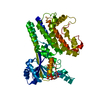+ Open data
Open data
- Basic information
Basic information
| Entry | Database: PDB / ID: 8h4m | |||||||||||||||||||||
|---|---|---|---|---|---|---|---|---|---|---|---|---|---|---|---|---|---|---|---|---|---|---|
| Title | Crystal Structure of GTP-bound Irgb6_T95D mutant | |||||||||||||||||||||
 Components Components | T-cell-specific guanine nucleotide triphosphate-binding protein 2 | |||||||||||||||||||||
 Keywords Keywords | IMMUNE SYSTEM / Toxoplasma gondii / PV / IRG / GTPase / HYDROLASE | |||||||||||||||||||||
| Function / homology |  Function and homology information Function and homology informationdefense response to protozoan / Hydrolases; Acting on acid anhydrides; Acting on GTP to facilitate cellular and subcellular movement / innate immune response / GTPase activity / GTP binding / endoplasmic reticulum / Golgi apparatus / membrane Similarity search - Function | |||||||||||||||||||||
| Biological species |  | |||||||||||||||||||||
| Method |  X-RAY DIFFRACTION / X-RAY DIFFRACTION /  SYNCHROTRON / SYNCHROTRON /  MOLECULAR REPLACEMENT / Resolution: 1.68 Å MOLECULAR REPLACEMENT / Resolution: 1.68 Å | |||||||||||||||||||||
 Authors Authors | Saijo-Hamano, Y. / Okuma, H. / Sakai, N. / Kato, T. / Imasaki, T. / Nitta, R. | |||||||||||||||||||||
| Funding support |  Japan, 6items Japan, 6items
| |||||||||||||||||||||
 Citation Citation |  Journal: To Be Published Journal: To Be PublishedTitle: Structural basis of Irgb6 inactivation by Toxoplasma gondii through the phosphorylation of switch I Authors: Okuma, H. / Saijo-Hamano, Y. / Sherif, A.A. / Hashizaki, E. / Sakai, N. / Kato, K. / Imasaki, T. / Nitta, E. / Sasai, M. / Kosako, H. / Standley, D.M. / Yamamoto, M. / Nitta, R. | |||||||||||||||||||||
| History |
|
- Structure visualization
Structure visualization
| Structure viewer | Molecule:  Molmil Molmil Jmol/JSmol Jmol/JSmol |
|---|
- Downloads & links
Downloads & links
- Download
Download
| PDBx/mmCIF format |  8h4m.cif.gz 8h4m.cif.gz | 101.2 KB | Display |  PDBx/mmCIF format PDBx/mmCIF format |
|---|---|---|---|---|
| PDB format |  pdb8h4m.ent.gz pdb8h4m.ent.gz | 74.6 KB | Display |  PDB format PDB format |
| PDBx/mmJSON format |  8h4m.json.gz 8h4m.json.gz | Tree view |  PDBx/mmJSON format PDBx/mmJSON format | |
| Others |  Other downloads Other downloads |
-Validation report
| Summary document |  8h4m_validation.pdf.gz 8h4m_validation.pdf.gz | 803.7 KB | Display |  wwPDB validaton report wwPDB validaton report |
|---|---|---|---|---|
| Full document |  8h4m_full_validation.pdf.gz 8h4m_full_validation.pdf.gz | 809.5 KB | Display | |
| Data in XML |  8h4m_validation.xml.gz 8h4m_validation.xml.gz | 18.2 KB | Display | |
| Data in CIF |  8h4m_validation.cif.gz 8h4m_validation.cif.gz | 25.9 KB | Display | |
| Arichive directory |  https://data.pdbj.org/pub/pdb/validation_reports/h4/8h4m https://data.pdbj.org/pub/pdb/validation_reports/h4/8h4m ftp://data.pdbj.org/pub/pdb/validation_reports/h4/8h4m ftp://data.pdbj.org/pub/pdb/validation_reports/h4/8h4m | HTTPS FTP |
-Related structure data
| Related structure data |  7vexS S: Starting model for refinement |
|---|---|
| Similar structure data | Similarity search - Function & homology  F&H Search F&H Search |
- Links
Links
- Assembly
Assembly
| Deposited unit | 
| ||||||||
|---|---|---|---|---|---|---|---|---|---|
| 1 |
| ||||||||
| Unit cell |
|
- Components
Components
| #1: Protein | Mass: 47344.703 Da / Num. of mol.: 1 / Mutation: T95D Source method: isolated from a genetically manipulated source Source: (gene. exp.)   References: UniProt: Q3T9E4, Hydrolases; Acting on acid anhydrides; Acting on GTP to facilitate cellular and subcellular movement |
|---|---|
| #2: Chemical | ChemComp-GTP / |
| #3: Water | ChemComp-HOH / |
| Has ligand of interest | Y |
-Experimental details
-Experiment
| Experiment | Method:  X-RAY DIFFRACTION / Number of used crystals: 1 X-RAY DIFFRACTION / Number of used crystals: 1 |
|---|
- Sample preparation
Sample preparation
| Crystal | Density Matthews: 2.22 Å3/Da / Density % sol: 44.58 % |
|---|---|
| Crystal grow | Temperature: 293 K / Method: vapor diffusion, sitting drop / Details: Sodium sulfate, polyethylene glycol 3350 |
-Data collection
| Diffraction | Mean temperature: 100 K / Serial crystal experiment: N |
|---|---|
| Diffraction source | Source:  SYNCHROTRON / Site: SYNCHROTRON / Site:  SPring-8 SPring-8  / Beamline: BL32XU / Wavelength: 1 Å / Beamline: BL32XU / Wavelength: 1 Å |
| Detector | Type: DECTRIS EIGER X 9M / Detector: PIXEL / Date: Feb 8, 2021 |
| Radiation | Protocol: SINGLE WAVELENGTH / Monochromatic (M) / Laue (L): M / Scattering type: x-ray |
| Radiation wavelength | Wavelength: 1 Å / Relative weight: 1 |
| Reflection | Resolution: 1.67→50 Å / Num. obs: 49012 / % possible obs: 99.8 % / Redundancy: 6.9 % / CC1/2: 0.998 / Net I/σ(I): 11.55 |
| Reflection shell | Resolution: 1.68→1.78 Å / Num. unique obs: 14962 / CC1/2: 0.475 |
- Processing
Processing
| Software |
| |||||||||||||||||||||||||||||||||||||||||||||||||||||||||||||||||||||||||||||||||||||||||||||||||||||||||
|---|---|---|---|---|---|---|---|---|---|---|---|---|---|---|---|---|---|---|---|---|---|---|---|---|---|---|---|---|---|---|---|---|---|---|---|---|---|---|---|---|---|---|---|---|---|---|---|---|---|---|---|---|---|---|---|---|---|---|---|---|---|---|---|---|---|---|---|---|---|---|---|---|---|---|---|---|---|---|---|---|---|---|---|---|---|---|---|---|---|---|---|---|---|---|---|---|---|---|---|---|---|---|---|---|---|---|
| Refinement | Method to determine structure:  MOLECULAR REPLACEMENT MOLECULAR REPLACEMENTStarting model: 7VEX Resolution: 1.68→37.88 Å / SU ML: 0.25 / Cross valid method: FREE R-VALUE / σ(F): 1.35 / Phase error: 24.72 / Stereochemistry target values: ML
| |||||||||||||||||||||||||||||||||||||||||||||||||||||||||||||||||||||||||||||||||||||||||||||||||||||||||
| Solvent computation | Shrinkage radii: 0.9 Å / VDW probe radii: 1.1 Å / Solvent model: FLAT BULK SOLVENT MODEL | |||||||||||||||||||||||||||||||||||||||||||||||||||||||||||||||||||||||||||||||||||||||||||||||||||||||||
| Refinement step | Cycle: LAST / Resolution: 1.68→37.88 Å
| |||||||||||||||||||||||||||||||||||||||||||||||||||||||||||||||||||||||||||||||||||||||||||||||||||||||||
| Refine LS restraints |
| |||||||||||||||||||||||||||||||||||||||||||||||||||||||||||||||||||||||||||||||||||||||||||||||||||||||||
| LS refinement shell |
|
 Movie
Movie Controller
Controller



 PDBj
PDBj


